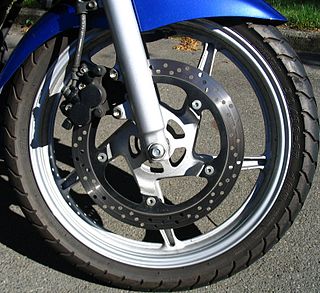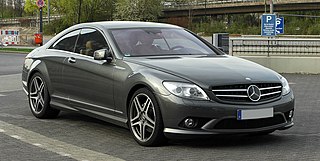
An anti-lock braking system (ABS) is a safety anti-skid braking system used on aircraft and on land vehicles, such as cars, motorcycles, trucks, and buses. ABS operates by preventing the wheels from locking up during braking, thereby maintaining tractive contact with the road surface and allowing the driver to maintain more control over the vehicle.

A brake is a mechanical device that inhibits motion by absorbing energy from a moving system. It is used for slowing or stopping a moving vehicle, wheel, axle, or to prevent its motion, most often accomplished by means of friction.

Electronic stability control (ESC), also referred to as electronic stability program (ESP) or dynamic stability control (DSC), is a computerized technology that improves a vehicle's stability by detecting and reducing loss of traction (skidding). When ESC detects loss of steering control, it automatically applies the brakes to help steer the vehicle where the driver intends to go. Braking is automatically applied to wheels individually, such as the outer front wheel to counter oversteer, or the inner rear wheel to counter understeer. Some ESC systems also reduce engine power until control is regained. ESC does not improve a vehicle's cornering performance; instead, it helps reduce the chance of the driver losing control of the vehicle.

Advanced driver-assistance systems (ADAS) are technologies that assist drivers with the safe operation of a vehicle. Through a human-machine interface, ADAS increase car and road safety. ADAS use automated technology, such as sensors and cameras, to detect nearby obstacles or driver errors, and respond accordingly. ADAS can enable various levels of autonomous driving.

In road-transport terminology, a lane departure warning system (LDWS) is a mechanism designed to warn the driver when the vehicle begins to move out of its lane on freeways and arterial roads. These systems are designed to minimize accidents by addressing the main causes of collisions: driver error, distractions and drowsiness. In 2009 the U.S. National Highway Traffic Safety Administration (NHTSA) began studying whether to mandate lane departure warning systems and frontal collision warning systems on automobiles.

The Mercedes-Benz W126 is a series of passenger cars made by Daimler-Benz AG. It was marketed as the second generation of the Mercedes-Benz S-Class, and manufactured in sedan/saloon (1979–1991) as well as coupé (1981–1990) models, succeeding the company's W116 range. Mercedes-Benz introduced the 2-door C126 coupé model, marketed as the SEC, in September 1981. This generation was the first S-Class to have separate chassis codes for standard and long wheelbases and for coupé (C126).

The Mercedes-Benz W221 is a chassis code of the fifth generation S-Class, produced from August 2005 until June 2013. The W221 S-Class was unveiled at the 2005 Frankfurt Motor Show as the successor of the Mercedes-Benz S-Class (W220) and the predecessor of the Mercedes-Benz S-Class (W222).

A motor vehicle has lighting and signaling devices mounted to or integrated into its front, rear, sides, and, in some cases, top. Various devices have the dual function of illuminating the road ahead for the driver, and making the vehicle visible to others, with indications to them of turning, slowing or stopping, etc., with lights also indicating the size of some large vehicles.

The Mercedes-Benz C216 is the last generation for the grand tourer with name Mercedes-Benz CL-Class, produced from 2006 to 2014. It replaced the C215 platform, and was replaced in 2014 by the C217 S-Class Coupe.

Adaptive cruise control (ACC) is a type of advanced driver-assistance system for road vehicles that automatically adjusts the vehicle speed to maintain a safe distance from vehicles ahead. As of 2019, it is also called by 20 unique names that describe that basic functionality. This is also known as Dynamic cruise control.

Vehicle safety technology (VST) in the automotive industry refers to the special technology developed to ensure the safety and security of automobiles and their passengers. The term encompasses a broad umbrella of projects and devices within the automotive world. Notable examples of VST include geo-fencing capabilities, remote speed sensing, theft deterrence, damage mitigation, vehicle-to-vehicle communication, and car-to-computer communication devices which use GPS tracking.

The Driver Monitoring System (DMS), also known as driver attention monitor, is a vehicle safety system to assess the driver's alertness and warn the driver if needed and eventually apply the brakes. It was first introduced by Toyota in 2006 for its and Lexus' latest models. It was first offered in Japan on the GS 450h. The system's functions co-operate with the pre-collision system (PCS). The system uses infrared sensors to monitor driver attentiveness. Specifically, the driver monitoring system includes a CCD camera placed on the steering column which tracks the face, via infrared LED detectors. If the driver is not paying attention to the road ahead and a dangerous situation is detected, the system will warn the driver by flashing lights, warning sounds. If no action is taken, the vehicle will apply the brakes. This system is said to be the first of its kind.

A collision avoidance system (CAS), also known as a pre-crash system, forward collision warning system (FCW), or collision mitigation system, is an advanced driver-assistance system designed to prevent or reduce the severity of a collision. In its basic form, a forward collision warning system monitors a vehicle's speed, the speed of the vehicle in front of it, and the distance between the vehicles, so that it can provide a warning to the driver if the vehicles get too close, potentially helping to avoid a crash. Various technologies and sensors that are used include radar (all-weather) and sometimes laser (LIDAR) and cameras to detect an imminent crash. GPS sensors can detect fixed dangers such as approaching stop signs through a location database. Pedestrian detection can also be a feature of these types of systems.

The World Forum for Harmonization of Vehicle Regulations define AEBS. UN ECE regulation 131 requires a system which can automatically detect a potential forward collision and activate the vehicle braking system to decelerate a vehicle with the purpose of avoiding or mitigating a collision. UN ECE regulation 152 says deceleration has to be at least 5 metres per second squared.
Emergency Assist is a driver assistance system that monitors driver behavior by observing delays between the use of the accelerator and the brake; once a preset threshold of time has been exceeded the system will take control of the vehicle in order to bring it to a safe stop.
Intersection assistant is an advanced driver-assistance system first introduced in 2009.

The Mercedes-Benz W205 is the fourth generation of the Mercedes-Benz C-Class which was produced by Daimler AG between 2014 and 2021. The W205 C-Class was preceded by the W204 C-Class and superseded by the W206 C-Class. The fourth-generation C-Class was available in sedan (W205), station wagon/estate (S205), coupe (C205), cabriolet (A205) and long-wheelbase sedan (V205) body styles.

The W213 Mercedes-Benz E-Class is the fifth generation of the Mercedes-Benz E-Class, sold from 2016 as a 2017 model. It succeeded the W212/S212 E-Class models. The coupe/convertible models share the same platform as the sedan/wagon, in contrast to the previous generation. The high-performance Mercedes-AMG E 63 and E 63 S versions of the W213 have been available as well from 2016, and these are the only versions with V8 engines.

Tristar Worldwide was a chauffeur-driven private hire car provider. The UK-based company operates in around 80 countries with an annual turnover of £48m and 650 employees. It was founded in 1978, originally for use by business class passengers of Virgin Atlantic. Tristar operates a fleet of 415 Volvo and Mercedes-Benz cars.
Automated lane keeping systems (ALKS), also described as traffic jam chauffeurs, is an autonomous driving system that doesn't require driver supervision on motorways. ALKS is an international standard set out in UN-ECE regulation 157 and amounts to Level 3 vehicle automation. It is essentially a more robust combination of adaptive cruise control (ACC) and lane centering assist (LCA). When activated, it allows the driver to do non-driving tasks until alerted otherwise.














